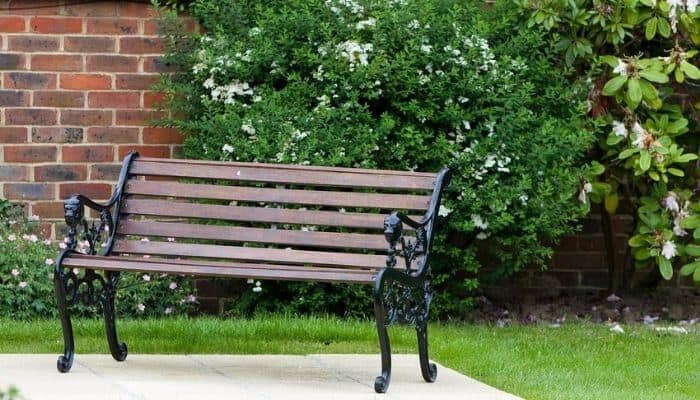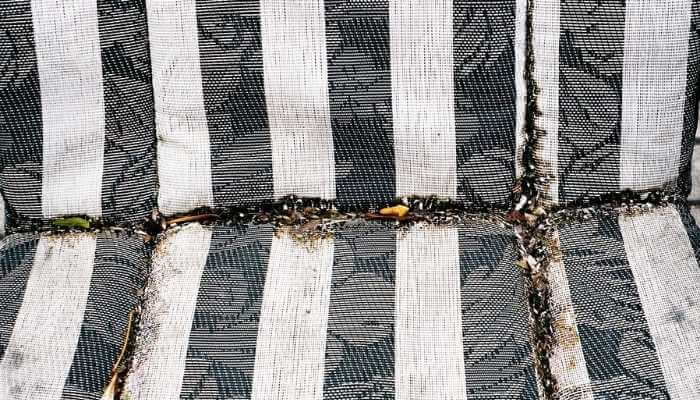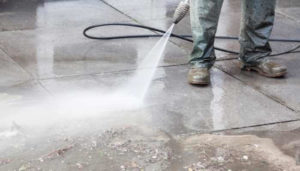Wrought iron outdoor furniture is metal furniture that is carved and molded by heating. This malleable iron is mixed with a slag filament then worked by a blacksmith into furniture. It literally becomes stronger the more it is worked.
Wrought iron is durable and corrosion-resistant, which is what makes it a good material for outdoor furniture. This product lends a classic, elegant look to patios and porches, no matter where they are.
Even though wrought iron furniture lasts the longest out of all of the types of outdoor furniture available, in order to maintain its beauty and longevity, you must subscribe to a plan of preventative care.
Keep in mind that covering your patio furniture while it is not in use can add years to the life of your investment, no matter what material it’s made of. But in this article, I plan to focus on wrought iron.
Is Powder Coating the Better Option for Wrought Iron?
Rust is your enemy when it comes to wrought iron. A manufacturing addition of powder coating can add an extra barrier against rust, but it also has its drawbacks. The process of powdering is supposed to be a guarantee that a piece won’t chip or fade, but apparently, that is not the case. In my research, I found that powder coating finishes can last up to 20 years. But there are a lot of factors that can break it down faster, like a substandard treatment process, consistent & constant use, exposure to UV light, and the outdoor environment it is in.
The experts at Dufferin Iron (40 years of experience in the industry) mention that they recommend paint for wrought iron over the powder coating. I’ll let them explain:
“While it’s true that a powder-coated product will look absolutely perfect on the day it arrives, it is not going to remain that way. This means that as a powder-coated metal fence or gate starts to lose its coating, the customer has only an expensive recourse. When your paint starts to show signs of wear and tear, it can be repainted on-site. But if you have a fence or railing that has been powder coated, the entire thing will need to be removed in order to be refinished.”
Dufferin Iron
Most pieces come already coated with a strong protectant and paint, so if you pay attention to it and keep it cleaned and handle any suspicious spots as soon as you find them, this should be fine.
How Often Should Wrought Iron Patio Furniture Be Cleaned?
You should be cleaning your wrought iron furniture with a damp cloth monthly. This is not only to remove dirt and dust but to also inspect the furniture for scratches and chips in the finish. You can also keep an eye out for rust-stained seepage from the more ornate surfaces that may be more difficult to clean.
What is the Best Way to Clean Your Wrought Iron Furniture?
For quarterly cleanings, you can use a hose and break out the mild soap and water like you would if you were washing your car. Soft cleaning cloths and maybe a toothbrush for hard-to-reach spaces are the things you should use on wrought iron.
You need to be sure not to use anything overly abrasive on metal furniture or you’ll end up with scratches and that makes your furniture even more susceptible to chipping, fading, and rust. Always rinse off all soaps with water and thoroughly towel dry the furniture.
How to Remove Rust & Calcium Build-Up from Wrought Iron Furniture
Calcium build-up tends to happen before, during, or after rusting. That’s because rust is most common where water has a high calcium concentration already. It shows up as small white specks on your furniture. And the longer they stay, the more difficult they are to remove. So do not ignore this.
Vinegar is your friend when you notice calcium build-up on your wrought iron furniture. It’s suggested by several articles to use a solution of 1 part white distilled vinegar and 9 parts water to help remove it. Always test the solution on an inconspicuous area of the wrought iron before applying to ensure it doesn’t discolor the finish.
If you spot rust, you should react quickly to get rid of it. Around the rust spot, clean the metal up with mild soapy water. Next, once the metal is dry, you can sand the area using sandpaper or a metal brush. Finally, seal the spot with paint.
If you ever have any scratches in the paint or chips, my suggestion is that you immediately whip out your sanding paper and then seal the spot with matching paint. That way, you can avoid rust altogether.
Also, never leave your wrought iron furniture in water or in a damp place. That only encourages both rust and calcium build-up.
Waxing to Protect Your Wrought Iron Outdoor Furniture
If you have a shiny or non-textured finish on your wrought iron furniture, you may want to use wax on it to help maintain the look. Coating your wrought iron furniture in car wax at least twice a year or after cleaning will add a layer of protection. Use a soft cloth in a circular motion to apply and polish the wax. As always, waxing usually helps in reducing the amount of dirt and debris that accumulates on the finish.
How Long Will My Wrought Iron Patio Furniture Last?
I have watched wrought iron furniture be passed down from generation to generation in my own family. The stuff can last upwards of 60+ years, it just needs the appropriate care and maintenance to keep it looking good.
In Closing
For the classic look of wrought iron in your outdoor living area, you need to be willing to take care of the furniture. If you are and you can afford the initial cost (which might not be much if you inherit it or find it used) the pay-off is an elegant seating area for you and your family and friends. It’s something you can change with a bit of paint and keep for a lifetime with the proper maintenance.
To get an idea of how wrought iron stacks up against the other materials in how long they last, you can check out our article here.













